Top News

May 5, 2013 Ryukyu Shimpo
After 10:00a.m. on May 1, at Ie Jima Auxiliary Airfield, the U.S. military conducted parachute training for soldiers jumping from MV-22 Osprey vertical takeoff and landing transport aircraft. One of the soldiers involved landed on private property outside that controlled by the military. He landed in pastureland, causing no damage to local residents or crops, but some residents were working in a field just 20 meters from where he landed. The U.S. military and Okinawa Defense Bureau did not give the Ie Municipal Office any advance warning that the training was to occur.
This is the first time that parachute training has occurred from MV-22 Osprey since the deployment of the aircraft to Okinawa.
A total of six soldiers from the U.S. Army Garrison Torii Station were involved in the training. One of them, who jumped from an Osprey aircraft, landed in pastureland about 80 meters away from the fence after being blown sideways by a strong wind.
The municipal government reported to the bureau that one of the U.S. servicemen landed in civilian property at 11:10 a.m. The bureau asked the U.S. military about this at 11:35a.m., requesting that they look into the cause and prevent any recurrence. The bureau then reported to the Military Base Affairs Division of the Okinawa Prefectural Government (OPG) at 2:25 p.m.
Ie Mayor Hideyuki Shimabukuro said, “We have been asking the U.S. military to call off the training in unsuitable weather conditions, but they do not. Something bad could have easily happened with local people working nearby.” Shimabukuro will ask the bureau to look into the cause and prevent recurrence.
Vice-Governor Kurayoshi Takara, said, “The OPG asks the U.S. military to strictly implement safety management procedures and to be very careful with this type of training.” On the same day, a representative of the OPG asked the bureau to prevent recurrence, saying, “This kind of incident makes local residents nervous.”
(English translation by T&CT, Mark Ealey)
Go to Japanese
April 25, 2013 Ryukyu Shimpo
On April 19, the Ada district of Kunigami in northern Okinawa and the NPO Yambaru Regional Revitalization Support Center reported to Kunigami Mayor Hisakazu Miyagi on their plan to link their community with the presence of the Yambaru kuina. In October 2012 Ada formally proclaimed itself as a habitat of this endangered species of bird.
According to the report the community has adopted five approaches that they hope to carry using lump-sum grants available from the municipal office. These are: 1) regional revitalization by co-existing with Yambaru kuina, 2) promoting industry through effective utilization of regional resources, 3) creating experience-based education opportunities and becoming a tourist hub in the eastern area of the community, 4) getting people to come for new attractions and 5) regional revitalization by encouraging young people to settle and promoting person-to-person exchanges.
Specifically, they suggested trying to attract larger numbers of tourists by using the Yambaru kuina as a symbol of the community, carrying out projects such as building structures in the community and along the roads to highlight the presence of the birds and trying to sell local products such as sugar cane and coffee beans under a brand name linked to the area being a habitat of the kuina. This plan also seeks to take of advantage of the natural environment, including doing work on old trekking routes, a local education center for the children who come from outside Okinawa, and upgrading a charcoal kiln in order to make charcoal out of a variety of ironwood introduced to the prefecture.
Ward Chief Yasuharu Kamiyama said, “By making use of our natural resources and the presence of the Yambaru kuina, which is the symbol of Ada, we want to try to develop the community in order to create jobs for young people.”
(English translation by T&CT, Hitomi Shinzato and Mark Ealey)
Go to Japanese
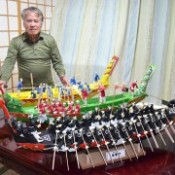
April 23, 2013 Ryukyu Shimpo
With the Naha Harii or dragon boat races being held from May 3 to 5, Genei Agena, a 75-year-old resident of Itoman made three models of dragon boats. The models, which took two years to complete, were presented to the Naha Municipal Office, where they were exhibited from April 23 to 30.
Each model boat was made using about 15,000 toothpicks. Agena said, “A lot of hard work went into making these. I hope that many people see them. I’m pleased that I could do something to help promote the Naha Harii.” The model dragon boat is about 110 centimeters long.
The green boat, Naha, and the yellow boat, Kume, have oarsmen on board preparing for a race and the black boat, Tomari, shows the oarsmen actually paddling. The base is made of toothpicks on which he used a chisel and plane to craft them into shape. The dragon decorations on the prow and stern are woodcarvings. The figures are made from toothpicks and paper clay and dressed with hand-sewn kimono. The oars are made from disposable wooden chopsticks.
Agena is from Matsuyama in Naha. Influenced by his late father Kokko, who was a Ryukyu lacquer-work craftsman, he has been making sculptures of one kind or another since he was a child. After he graduated Naha High School, Agena worked in the photo-engraving business in Tokyo before returning to Okinawa where he worked in Matsuyama. Agena developed an interest in Naha’s festivals because his father handled hatagashira, the large flagpoles used in the Naha Tug-of-War.
He is particularly attracted to the Harii dragon boat events and every year he goes to the festival. Agena always gets excited when the main event of the festival, the Ugan Barii, starts. For these reasons, he has long dreamed of making models of Naha Harii and when he retired he spent much of his time working on these models, finishing them in two years.
While he pleased with the result of his efforts, saying, “They worked out really well if I say so myself.” He went on to say, “I couldn’t make these again though. It was really hard work.” But at the same time, he hinted at his next project, saying, “But making a sabani might be easier.”
(English translation by T&CT, Lima Tokumori and Mark Ealey)
Go to Japanese
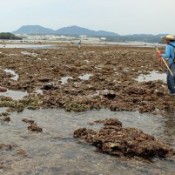
April 28, 2013 Ryukyu Shimpo
On April 27, many people enjoyed digging clams at Henoko beach in Nago, near where the U.S. military plans to construct an alternative facility for Futenma Air Station. With an area of sea full of colorful coral in front of them, people questioned why part of these waters need to be filled in.
This was one of the few days of the year on which there is a large tidal variance, so about one kilometer of the reef connecting the Henoko shoreline with Nagashima was visible. People could walk out to see the coral and at low tide at 2:00pm there were many people who enjoyed doing this and fishing off the reef.
Seijun Higa, a 73-year-old resident of Henoko who visited the beach with his family, said, “Most of the coral died due to bleaching a dozen or so years ago, but it is starting to grow back quite nicely. But it’s not quite as large as it used to be. It could get worse if the base is constructed near here.”
(English translation by T&CT, Lima Tokumori and Mark Ealey)
Go to Japanese
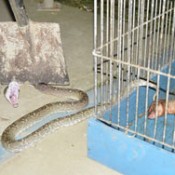
April 25, 2013 Ryukyu Shimpo
In the night of April 22, Shincho Tawada, a 73-year-old resident of Shimashi, Ginowan, captured a venomous pit viper, which is also known in Okinawa as a habu. Tawada discovered the snake when it was in the act of swallowing a mongoose that he kept in a birdcage in his house. He grabbed the snake when it tried to slip away from the scene, vomiting up the mongoose as it went.
On April 21, Tawada caught the mongoose, a natural enemy of these vipers, in his field in Nakagushiku Village. He set a trap after having been troubled by mongooses eating his chickens’ eggs. Tawada brought the mongoose into the house and put it in a birdcage to show it to his grandson who was interested in the animal.
When he checked on the mongoose at around 9:00pm on April 22, he found that a pit viper had somehow got through the wire into the cage and was in the process of swallowing the mongoose.
Tawada has seen snakes in his house before – in fact twelve years ago he was bitten on the back of his head by one. The season when the snakes are dormant has finished, so they are more active now. Tawada said, “I’ll have to do something to keep them out.”
(English translation by T&CT, Mark Ealey)
Go to Japanese

April 24, 2013 Ryukyu Shimpo
On April 23, the Okinawa Prefectural Government (OPG) announced that a venomous snake of the Sakishima-habu variety was caught on Miyako-jima. According to the OPG, this is the first time that such a snake has been caught in Miyako, which is known as an island that does not have habu. The Pharmaceutical Affairs and Disease Control Division of the OPG warns people not to approach a snake if they ever come across one and instead to contact the police to ask them to catch it. The authorities also request that residents seek medical attention immediately if they are bitten by a snake. The Miyako Public Health Center has several antitoxins available in the Prefectural Miyako Hospital to use in the case of habu bites.
The Sakishima-habu that was caught is a male, 44 centimeters long and weighing 16 grams. Judging from its size it is a young snake, between six and eighteen months old. It is unknown whether the snake was born on the island or if someone brought it there from outside Miyako-jima. On April 19, during his lunch break, a resident found the snake at the park in the urban district near Hirara Port. He grabbed it with his bare hands, put it into a plastic bottle and delivered to the Miyako Public Health Center.
According to the National Institute for Environmental Studies, Sakishima-habu mainly inhabit Iriomote, Kohama, Taketomi, Kuroshima and Ishigaki in the Yaeyama Islands. They are also found in the southern part of Itoman on the main island of Okinawa. There have also been cases in which they have been caught in Tamagusuku in Nanjo, as well as in Naha and Nago.
(English translation by T&CT, Mark Ealey)
Go to Japanese
April 30, 2013 Ryukyu Shimpo
With such a large turnout at the rally protesting against the central government’s celebration of the date of restoration of Japan’s sovereignty on April 28, the rally’s executive committee have decided to send a written resolution to Prime Minister Shinzo Abe. The committee members will meet on April 30 to decide how and when to send the resolution.
The executive committee members of the rally held in Yaeyama sent a resolution to Abe on April 29.
Masaharu Kina, the co-leader of the rally, emphasized the significance of the event, saying, “I was concerned about the rally because of the short amount of time we had to prepare, but that so many people came along made me feel better about civil movements in Okinawa and more confident about their future.” Kina went on to say, “I want to take this occasion to promote further movements aimed at regaining Okinawa’s sovereign rights.” Kina said that the organizers of the rally will tackle issues faced by Okinawa, such as further deployment of Osprey aircraft, and the relocation of U.S. Marine Corps Air Station Futenma to the Henoko district of Nago.
Kina indicated that in his opinion he would like people to consider making the rally an annual event.
Mio Nakamura, the executive director of the committee, said, “The people who came seemed to want the voice of the Okinawan people to be heard. This is a very serious matter which they cannot allow to go unnoticed. It has caused considerable anger. Many people were united in holding this rally because the people of Okinawa are not able to compromise any more on issues related to history textbooks and reclamation of land within the prefecture for the alternative facility of Futenma Air Station.”
The resolution said, “Holding this ceremony means trampling on the feelings of the Okinawan people and once again cutting the prefecture adrift. We will not tolerate this kind of ceremony.” It continued, “We hereby express our indignation and issue a strong protest against the central government having held the ceremony.”
(English translation by T&CT, Mark Ealey)
Go to Japanese
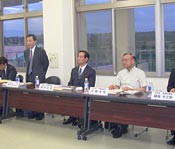
April 23, 2013 Yoko Ikeda, correspondent of Ryukyu Shimpo
On April 22, ten people including staff of the headquarters of the government’s Trans-Pacific Partnership Free-Trade Agreement (TPP) Task Force and Diet members of the Liberal-Democratic Party visited the Minami Daito Municipal Office to exchange opinions with Mayor Kensho Nakada. The village has developed on sugar production as its main industry since 1900. Mayor Nakada voiced his feelings of unease, saying, “If participation in the TPP negotiations does not bring any result in terms of creating exceptions for tariff elimination, the island will not survive.” House of Representatives member Mitsuhiro Miyakoshi replied, “We are not going to abandon sugarcane. We will protect Okinawa’s sugarcane at any cost.
Before exchanging opinions, municipal office staff presented a slideshow explaining the sugar production process from sugarcanes and asked for understanding towards protection of sweetening resources.
Mayor Nakada said, “Entry into the TPP negotiations, will bring change to regional systems and situations. People are all concerned about the future of this island.” House of Representatives member and head of the Liberal-Democratic Party TPP Task Force Committee Koya Nishikawa said, “Hearing people’s opinions, we have confirmed our stance that we will protect agriculture together. We will do our best with the same resolve that you show.”
(English translation by T&CT, Megumi Chibana and Mark Ealey)
Go to Japanese

April 26 2013 Ryukyu Shimpo
In the evening on April 25, a panel discussion was held on the topic of the Japanese government planning to hold a ceremony on April 28 to commemorate the anniversary of the restoration of Japanese sovereignty after the San Francisco Peace Treaty took effect in 1952. Held at the Ryukyu Shimpo Hall in the Izumizaki district of Naha, the discussion was sponsored by the Ryukyu Shimpo newspaper, Okinawa Television Broadcasting and Radio Okinawa
Five panelists discussed the significance of April 28, the date on which Okinawa was separated from Japan and placed under U.S. occupation, as well as the topic of sovereignty for Okinawa and Japan. About 620 people attended the panel discussion to gain a better understanding of these issues. The panelists also discussed whether or not Okinawa should seek to gain independence from Japan.
With regard to the Okinawan people’s opposition to the central government’s celebration of the date of restoration of Japan’s sovereignty, Naha Mayor Takeshi Onaga criticized Prime Minister Shinzo Abe, saying, “This has awoken a sleeping dog in Okinawa. In Abe’s mind, the issue of Okinawa was somewhere far off away in a corner.” With regard to the Abe administration becoming more conservative after the ceremony, Onaga said, “Rather than amending the Japanese constitution, revising the Japan-U.S. Status-of-Forces Agreement would allow Japan to regain its sovereignty.” Onaga emphasized the importance of everyone in Okinawa opposing the ceremony and establishing Okinawa’s sovereignty.
Writer Masaru Sato criticized the ceremony, saying, “The Japanese government’s celebration of the restoration date by referring to it representing the complete return of its sovereignty runs counter to its ongoing demands for the return of the Northern Territories. The central government decided to hold the ceremony without acknowledging that April 28 was actually the date that Okinawa was separated from Japan.” With regard to the Emperor Showa verbally requesting that the U.S. government continue the military occupation of Okinawa for an extended period of time, Sato said, “The people of the main islands of Japan avoid discussing the emperor but the Okinawan people do discuss this matter. They react differently to the emperor.”
Professor emeritus of the University of the Ryukyus, Kiko Nishizato, who specializes in modern history, criticized the ceremony, saying, “The U.S. government influences the Japanese government’s policies for relocation of Futenma Air Station within Okinawa, Japan’s participation in the Trans-Pacific Partnership and the reactivation of nuclear power plants. The ceremony is an attempt to cover up the reality of Japan’s subordination to the United States.”
Keiko Katsukata-Inafuku, a professor of Waseda University, who is originally from Okinawa, also criticized the ceremony, saying, “Although I consider that the Okinawan governor’s decision not to attend the ceremony is the right one, I think that the vice governor’s attendance does not show respect for Okinawan people’s feelings. I want the Okinawa Prefectural Government to indicate its intention to the Japanese government in some way.”
Yasukatsu Matsushima, a professor of Ryukoku University, who calls for Ryukyuan independence, said, “Militarization to enhance the islands defense could expose the Ryukyu Islands to the risk of being sacrificed by a mistaken national strategy. Ryukyu becoming completely independent is the best way to resolve the U.S. military base issues.”
(English translation by T&CT, Mark Ealey)
Go to Japanese
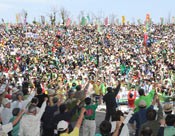
April 29 2013 Ryukyu Shimpo
April 28 marked the 61st anniversary of the restoration of Japanese sovereignty after the San Francisco Peace Treaty took effect in 1952 and when Okinawa was separated from Japan and placed under U.S. occupation. On this day, from 11:00am at the open-air amphitheater at Ginowan Seaside Park opposition parties, centrists in the Okinawa Prefectural Assembly and citizen groups held a rally to protest against the central government celebration of the date of restoration of Japan’s sovereignty.
According to organizers, more than 10,000 people participated in the rally, including some who could not actually enter the theater. They protested against the commemoration ceremony held by the Japanese government around the same time in Tokyo. The participants passed resolutions and put up slogans to protest against the holding of the ceremony, stating, “We will not tolerate the ceremony because it tramples on Okinawa people’s feelings and cuts the prefecture loose again.”
In concert with the rally held in Okinawa, rallies were also held in Miyako-jima and Amami in Kagoshima Prefecture. Citizens held several rallies in Tokyo.
In Okinawa, political parties and municipalities that did not participate in the rally conducted various activities to protest against the ceremony. The anger against the administration led by Prime Minister Shinzo Abe, who forced through holding of the ceremony, has swept through Okinawa.
The rally began with people singing of the song Return Okinawa to Okinawans, a variation of the song entitled Return Okinawa, which the participants in the Okinawa reversion movement used to sing.
Chairman of the Okinawa Prefectural Assembly Masaharu Kina protested against the ceremony saying, “Japan cannot be termed a democratic country because the current administration is subordinate to the U.S. government and its policies ignore the citizens of Japan.”
Tetsumi Takara, a professor of the University of Ryukyus and a manager of a research group called the Committee for Creating Peace in Okinawa and Regaining Human Dignity, and Masako Ishimine, the head of the Okinawa Prefectural Women’s Groups Liaison Council, both gave speeches.
In an address to express his solidarity, Susumu Inamine, mayor of the Nago region where the U.S. military plans to relocate Futenma Air Station, said, “The Japanese government rides roughshod over the human rights of the Okinawan people. I certainly do not see any restoration of Japan’s sovereignty.”
Hidekatsu Nakamura, the chairman of the Zamami Village Assembly, expressed his anger about the ceremony, saying, ” Japan is not a sovereign nation as long as the Status of Forces Agreement is discriminatory towards Japanese citizens.”
Kiku Nakamura, a survivor of the Shiraume-tai, a group of Japanese schoolgirls assigned by the Imperial Japanese Army to serve as nurse-aides during the Battle of Okinawa, said, “The Japanese government’s stance is entirely insensitive to the suffering of the Okinawan people and reflects a lack of understanding of history.”
Kaoru Kinjo, of the Young Men’s Association in Okinawa, said, “Today is the day on which all Japanese citizens take an important step towards finding a way to resolve issues related to Okinawa.”
The participants passed resolutions and adopted slogans, wind up the rally by shouting “Gatinnaran! (We will not put up with this!)” five times.
As members of the Okinawa branch of the Komeito Party who chose not to participate in the rally criticized the ceremony in a street speech, members of the ruling parties protested against the ceremony.
Slogans of the rally
■ We will not put up with the Japanese government celebrating a day of humiliation on which Okinawa was separated from Japan and placed under U.S. occupation in 1952, as the day Japan recovered its sovereignty.
■We demand that the Japanese government immediately remove the flawed military aircraft the Osprey from Okinawa and rescind the plan to also deploy the aircraft to Kadena Air Base.
■We demand that both the U.S. and Japanese governments move to immediately close Futenma Air Station and remove the base, abandoning the plan to relocate it within the prefecture.
■We will make Okinawa a peaceful place with a rich natural environment free from military bases.
(English translation by T&CT, Mark Ealey)
Go to Japanese
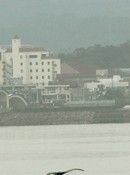
April 13 2013 Ryukyu Shimpo
At 3:00pm on April 12, three humpback whales were reported to be swimming in Nago Bay. They swam around the bay during for about 90 minutes, occasionally showing their tail fins above the surface of the water, and blowing water into the air. They were snuggling up closely to each other so they are probably parent and child.
Humpback whales spend time in Arctic waters during summer and then move south to breed in winter, appearing in the sea around Nago from January to March. Local people say that whales have moved on by the time the Shimi Festival season comes around, and so this is probably the last look at whales this season. The Shimi Festival, in which the people of Okinawa honor ancestral spirits, is held during March of the lunar calendar.
Many tourists and local residents watching the whales stopped their cars along National Highway No. 58 in the stretch of road from the roadside station at Kyoda to Agarie. Cheers rose from children each time the whales blew.
(English translation by T&CT, Mark Ealey)
Go to Japanese









 Webcam(Kokusai Street)
Webcam(Kokusai Street)


